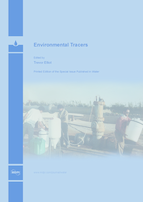Environmental Tracers
A special issue of Water (ISSN 2073-4441). This special issue belongs to the section "Water Quality and Contamination".
Deadline for manuscript submissions: closed (30 November 2013) | Viewed by 96787
Special Issue Editor
Interests: intelligent tracers for environmental & engineering systems, eg natural, ambient environmental tracers (including stable isotopes, noble gases, CFC’s, SF6, environmental radioactivity) and/or applied tracers; geohydrology; isotope hydrology; groundwater dating; aquifer sustainability issues
Special Issue Information
Dear Colleagues,
Aquifer resources continue to be overexploited, leaving the world's most impoverished (or vulnerable) populations and/or the aquatic environment at an ever increasing risk from climate change. Adaptation strategies demand detailed evaluation and management of water as a resource, requiring an understanding of the chemical, geological (hydrogeological/geohydrological) and biological interactions that waters effect or undergo in the hydrologic cycle. Environmental tracers are ambient natural or man-made compounds widely distributed in the Earth’s near-surface. They may be injected into the hydrological system from the atmosphere at recharge and/or are added/lost/exchanged inherently as waters flow over and through materials. Variations in their chemical abundances and isotopic compositions can be used as tracers to determine sources (provenance), pathways (of reaction or interaction) and also timescales (dating) of environmental processes. Water dating may invoke their characteristic decay or accumulation functions, (cf. radioactive and radiogenic compounds and isotopes) in a system or the characteristic injection of sources. Environmental tracers in groundwater systems can give information both on current and past flow conditions independently of hydraulic analyses and modelling. Thus, environmental tracers generically are important tools for developing sustainable management policies for the protection of water resources and the aquatic environment.
Recent overviews have highlighted how most environmental tracer systematics have become well-established through proof-of-concept studies in geochemically and hydraulically simple aquifers. The challenge now lies in enhancing the way they are put to use by the hydrologic community and water resource managers in more complex systems (e.g. inter- and intra-aquifer mixing; aquifers as distributed water systems – water coming in at one point is going somewhere, and pumping of water represents an interception) and how they may be used to address issues of vulnerability, sustainability, and uncertainty in water resource systems (including resource, flooding, drought, climate justice, water and food security, water footprints, etc.).
Therefore we would like to call for papers to disseminate and share findings especially on the robustness or fitness-for-purpose of the application and use of environmental tracers in water resource systems in addressing problems and opportunities scientifically. Papers are selected by a rigorous peer review procedure with the aim of rapid and wide dissemination of research results, development and application in the wide area of environmental tracers. Original research papers or critical reviews are invited.
Dr. Trevor Elliot
Guest Editor
Manuscript Submission Information
Manuscripts should be submitted online at www.mdpi.com by registering and logging in to this website. Once you are registered, click here to go to the submission form. Manuscripts can be submitted until the deadline. All submissions that pass pre-check are peer-reviewed. Accepted papers will be published continuously in the journal (as soon as accepted) and will be listed together on the special issue website. Research articles, review articles as well as short communications are invited. For planned papers, a title and short abstract (about 100 words) can be sent to the Editorial Office for announcement on this website.
Submitted manuscripts should not have been published previously, nor be under consideration for publication elsewhere (except conference proceedings papers). All manuscripts are thoroughly refereed through a single-blind peer-review process. A guide for authors and other relevant information for submission of manuscripts is available on the Instructions for Authors page. Water is an international peer-reviewed open access semimonthly journal published by MDPI.
Please visit the Instructions for Authors page before submitting a manuscript. The Article Processing Charge (APC) for publication in this open access journal is 2600 CHF (Swiss Francs). Submitted papers should be well formatted and use good English. Authors may use MDPI's English editing service prior to publication or during author revisions.
Keywords
- environmental tracers
- water dating, transit and residence times
- complex systems
- inter- and intra-aquifer mixing
- distributed systems
- vulnerability, sustainability, and uncertainty in water resource systems






